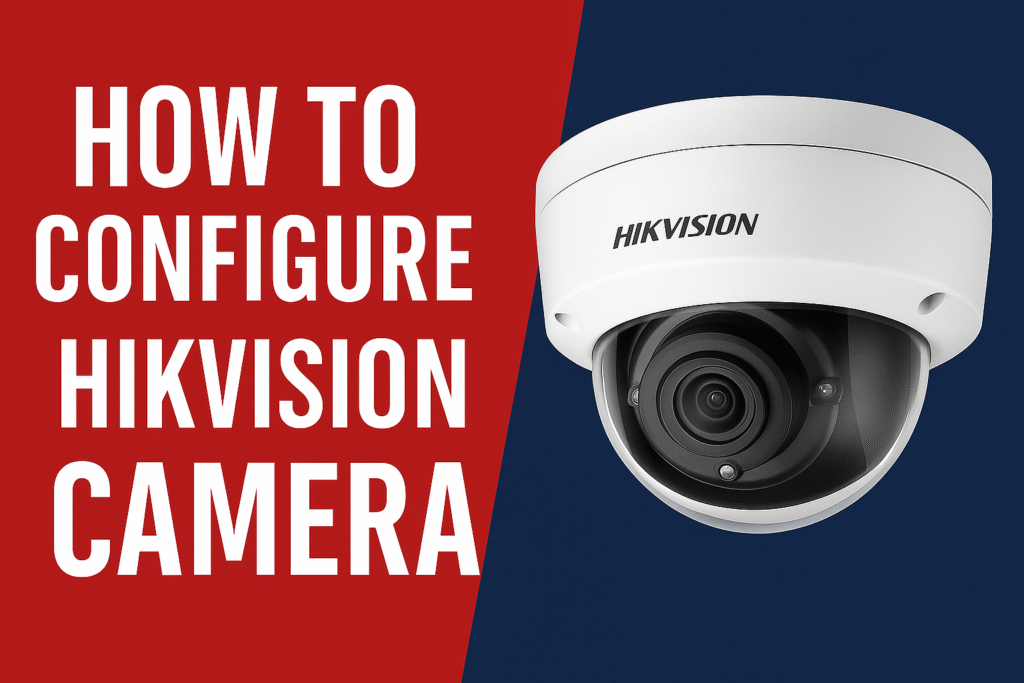
Are you looking for an easy and reliable way to configure Hikvision camera? whether you are securing your home, hotel, office, or any commercial property, this complete guide to Hikvision camera setup will help you connect, configure, and optimize your IP camera for the best performance. In this post, you’ll learn everything from physical installation to advanced remote access settings.
Many users fail to properly configure Hikvision camera network settings, resulting in connectivity issues
✅ What You’ll Learn in This Configure Hikvision Camera Guide
Why You Should Configure Hikvision Camera Correctly
- How to install a hikvision ip camera
- How to find and change ip address using SADP tool
- How to configure settings for live view, motion detection and alerts
- Tips for remote access, Hik-Connect setup, and advanced features
- SEO Tip: Use this blog with keywords like “Hikvision IP camera setup,” “configure Hikvision NVR,” or “CCTV camera installation step-by-step.”
🧰Step 1: Physical Setup to Configure Hikvision Camera
Unbox and Prepare the Camera:
- Check the camera, screws, power adapter, user manual, and mounting bracket.
- Select a location that covers the desired surveillance area.
- For outdoor models, ensure waterproofing is in place.
Connect the Camera:
- Plug in the power cable or use a PoE switch for power + data.
- Connect the Ethernet/LAN cable to your router or switch.
📌 Tip: Always use a surge protector to avoid hardware damage.
🌐Step 2: Detect and Configure Hikvision Camera Using SADP Tool
Hikvision’s SADP Tool (Search Active Device Protocol) helps detect the IP camera in your local network.
- Download & Install SADP Tool from Hikvision Official Site.
- Open the tool and wait for it to display the connected devices.
- You’ll see your device’s model, IP address, and status.
- Select the device, activate it by setting a strong password.
📌 Pro Tip: Change the default IP to a static IP to avoid IP conflict later.
🛠 Step 3: Log in to Configure Hikvision Camera via Web Interface
- Open a browser (Google Chrome/Edge).
- Enter the camera’s IP address in the URL bar.
- Log in with your username and password.
- You’ll enter the Live View dashboard with menu options.
Important: Always change default login credentials to keep the device secure.
📡 Step 4: Network Settings to Configure Hikvision Camera for Remote Access
To view the camera from your phone or another location, you need to configure the network settings properly:
- Set Static IP: Avoid using DHCP if you want stable remote access.
- Configure Gateway and DNS: Match your router’s network details.
- Enable Hik-Connect Cloud:
- Go to Configuration > Network > Advanced Settings > Platform Access
- Enable Hik-Connect and register your device
- Scan the QR code in the Hik-Connect app to link your mobile
📲 Download the Hik-Connect app on Android or iOS for live viewing.
🎥 Step 5: Configure Hikvision Camera Video & Image Settings
- Go to Configuration > Video/Audio
- Choose:
- Resolution: 1080p or higher for clear video
- Frame Rate: 15–25 FPS is ideal
- Video Compression: Use H.265+ to save bandwidth and storage
- Adjust brightness, contrast, WDR (wide dynamic range), and IR mode
🚨 Step 6: Configure Hikvision Camera Motion Detection & Alerts
- Go to Event > Basic Event > Motion Detection
- Enable it and draw a motion detection zone.
- Set email alerts or app push notifications for real-time alerts.
- Enable Tampering Alarm and Intrusion Detection (on supported models).
🎯 SEO Tip: Use this section to rank for “motion detection on Hikvision camera” or “CCTV push notifications.”
🔐 Step 7: Secure and Configure Hikvision Camera Settings
Security is crucial. Here are must-do settings:
- Change all default passwords
- Use HTTPS and enable Encryption
- Disable unused services like Telnet or UPnP
- Keep firmware up to date from Hikvision Firmware Download Portal
🧠 Bonus Tips: Storage and Smart Features
- Local Storage: Insert an SD card (for supported models)
- NVR Storage: Connect your camera to a Hikvision NVR for 24×7 recording
- NAS Support: Configure network storage via SMB or NFS
🔍 Also explore features like:
- Line Crossing Detection
- Face Detection (on supported models)
- Audio Input/Output Configuration
✅ Final Checklist to Configure Hikvision Camera Successfully
- Camera physically installed and connected
- IP address configured and accessible
- Live view and recording verified
- Motion detection and alerts tested
- Remote access via Hik-Connect working
- Firmware updated
- Admin password secured
💬 Conclusion
Setting up your Hikvision CCTV camera correctly ensures maximum security, smooth monitoring, and long-term reliability. This guide covers everything from installation to advanced settings to help both beginners and IT professionals.
If you’re in the hotel industry, apartment security, or managing multiple cameras, following this setup guide will save time and reduce technical errors.
- How to Fix Printer Error 0x0000011B in Windows
- Step-by-Step Guide to Creating a Shared Folder in Windows
Hikvision Download link
Download SADP Tool – Hikvision
📌 Keywords Used:
Hikvision IP camera setup, configure CCTV camera, SADP tool, NVR connection, CCTV remote access, Hikvision motion detection, hotel camera setup, Hik-Connect, Hikvision troubleshooting

Leave a Reply